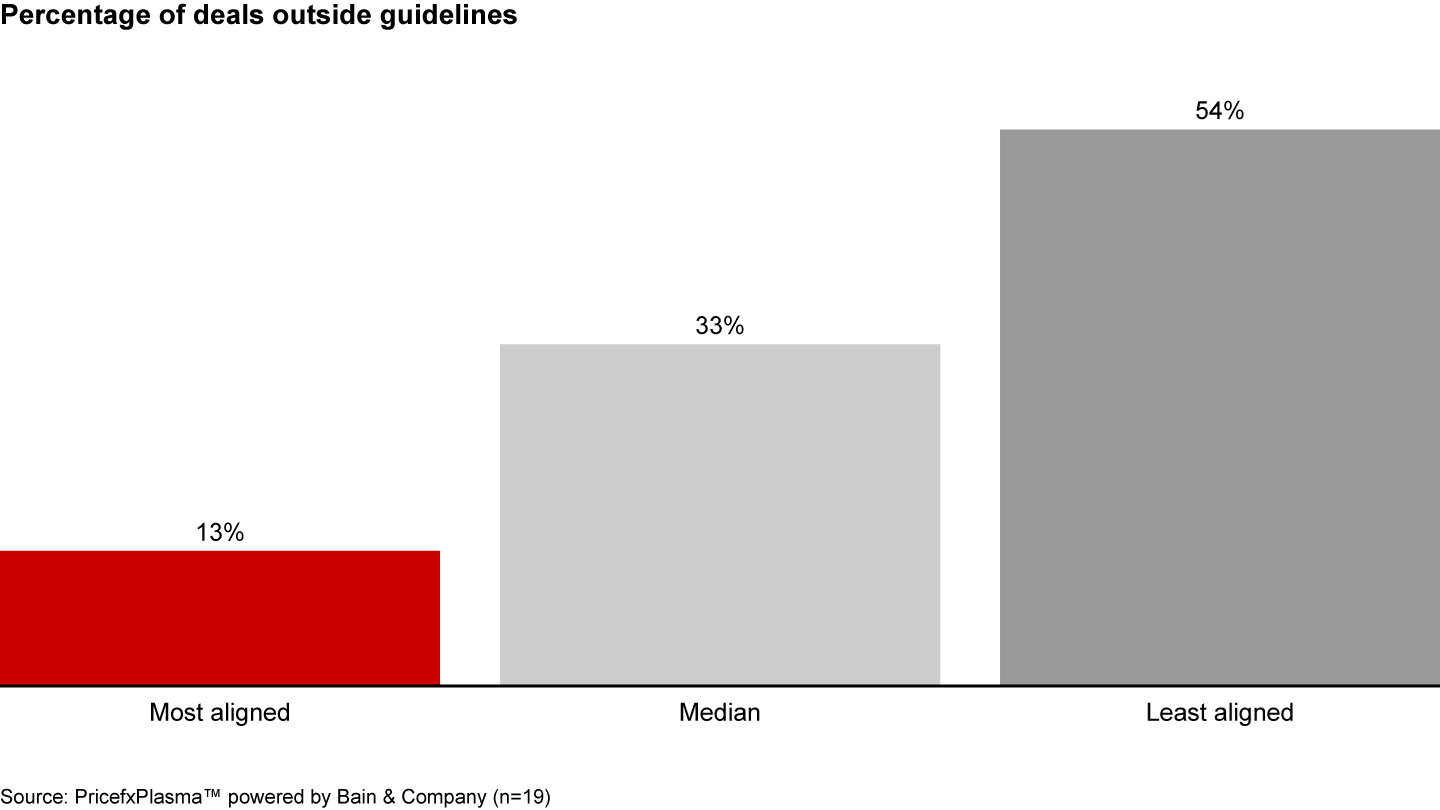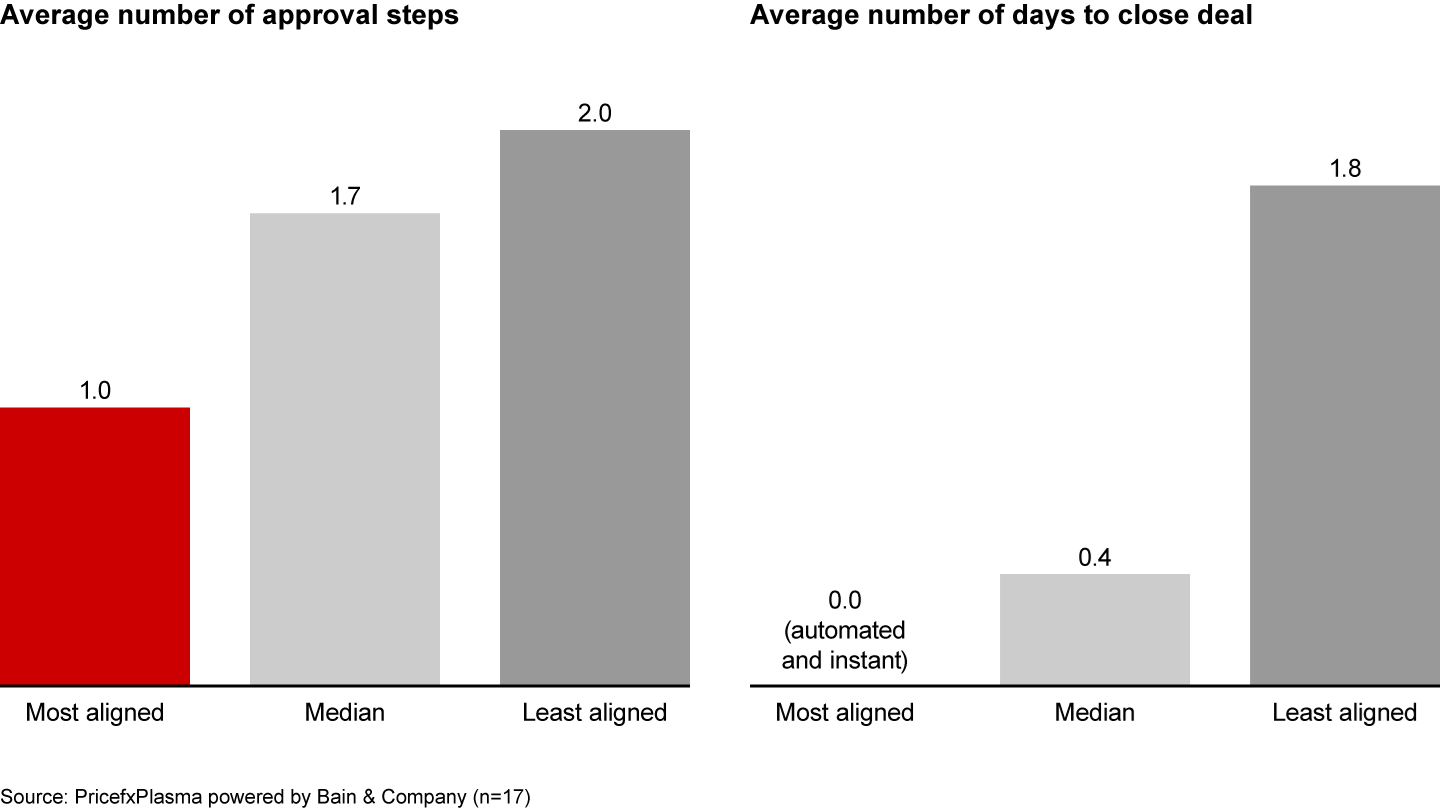Brief

Executive Summary
- List price aside, the price a B2B company actually realizes hinges on sales, pricing, and other functions working together.
- At many companies, however, the functions are misaligned, causing slower sales cycles and lower profits.
- To stop the conflict and its root causes, companies can align incentives to both profit margin–based metrics and qualitative objectives, and foster collaboration through training and rotational programs.
- Above all, they should make it easy to do the right thing, through clear policies and pricing guidance.
Although sales and pricing teams are both essential to generating profitable revenue in business-to-business companies, they’re often at odds. The feud between those who carry the bag and those who price it erupts every day:
“You don’t understand my account—I know they will deliver more next quarter.”
“Why do you always seem to give freight away?”
“You just don’t know what it takes to get in the door.”
The sales group knows the customer’s needs and what’s required to win with an account. Pricing takes a more analytical view of the market and the policies tailored to a segment, even if it means losing a few deals along the way. Many sales organizations have hundreds or thousands of representatives, while centralized pricing functions may work with just a dozen individuals, but the balance of power varies among companies. Credibility, C-suite access, and underlying capabilities all play a role. Yet in any B2B organization, delivering the right price requires sales, pricing, marketing, and product functions to work hand in hand.
The costs of misalignment
Symptoms of misalignment show up in measures of internal performance. For example, misaligned companies largely govern pricing by exception. Based on a sample from Bain’s pricing database, maintained in partnership with Pricefx from a shared pool of firms’ pricing operations and transactions, 54% of those companies price deals outside of guidelines, as opposed to just 13% of aligned firms (see Figure 1).
Companies with aligned sales, pricing, and other functions have many fewer deals closing outside of pricing guidelines


Misaligned companies also have twice as many deal approval handoffs, resulting in much longer deal cycle times (see Figure 2). All of this might be acceptable, except that transactional profit outcomes also tend to be lower for the companies that expend more time and resources to get to an answer—18% of list price vs. 40% for aligned firms.
Aligned companies have fewer deal approval handoffs and faster deal cycle times


Take the case of one technology distribution organization, whose salesforce was signing many deals far outside of policy boundaries. In a low-margin business, even slight deviations added up to a significant hit to the bottom line. The problem stemmed from a disconnect between pricing strategies and the realities of sales execution. Simplistic pricing guidance and policies were ignored in the bid to increase volume, which sales leaders had set as the primary factor for compensation. Governance over deal pricing was minimal, so sales staff often offered deals without seeking approval. Moreover, poor visibility of costs to serve led to incorrect assumptions about transaction profitability.
Mending fences, bridging the divide
To strengthen commercial outcomes, senior leaders should first take stock of the signals of dysfunction, including these:
- Functional blinders. Silos make it difficult for employees to communicate what’s required or exchange ideas. Different groups may work in different locations and rarely interact in person.
- Incentive tugs-of-war. Conflicting compensation and incentive structures can cause confusion about goals and exacerbate tensions.
- One-sided programs. The pricing or marketing team might be left to manage aggressive profitability goals with no sales sponsorship or engagement. Limited enforcement of guidelines hampers their ability to manage toward financial objectives.
- Blind negotiations. Delivering the right price requires embedding pricing guidance into the sales process. Without it, sales teams are forced to optimize for a given client or situation, making trade-offs without the full benefit of pricing intelligence spanning all clients, categories, and transactions.
With these hurdles in mind, leaders should make adjustments on several fronts:
- Align incentives to both profit margin–based metrics and qualitative objectives, so that pricing and sales are marching in the same direction.
- Foster empathy through cross-functional training and a rotational program. Sales teams should understand how the guidelines work, while pricing teams must be educated on the realities of the sales floor. Having pricing staff ride along on sales calls can help them understand these challenges.
- Make it easy to do the right thing. Provide clear policies, pricing guidance, and projected results of pricing decisions so that frontline sales reps can make fully informed choices. This might include the effects on compensation, required approvals, and comparisons to peers’ pricing performance for similar deals.
- Identify champions by sharing best pricing practices in the sales group.
Some of these steps were taken by the technology distribution company described earlier, in order to address its problems. For instance, it designed analytically driven pricing guidance for sales reps through its configure, price, quote system. It adjusted pricing policies so that frontline sellers had more authority to execute, but also gave them better information to inform good decisions. The company simplified the approval process for exceptions but created stronger policies on discounting and cost-to-serve concessions, such as free freight and expedited orders. Collectively, these steps delivered a nearly 25% lift in pretax earnings and established an aligned partnership between sales and pricing.
Whether a company is refreshing its pricing strategy, adjusting for inflation, or looking to stem price leakage, cross-functional collaboration and alignment are critical in making the results stick.